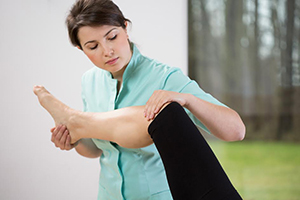Health Blog
PT program better than education for knee osteoarthritis

Common condition not given enough attention as it deserves
Knee osteoarthritis (OA) is a painful condition in which protective cartilage gradually wears away. OA of the patellofemoral joint (PFJ) is one type of knee OA that's present in nearly 70% of adults with knee pain, but the condition is not given the attention it deserves. PFJ OA patients are typically treated with conservative (non-surgical) interventions like physical therapy that tailored specifically to the location of joint damage, yet there's not enough research to support this type of treatment. To get a better sense of how effective these treatments are and if they should be used, a powerful study called a randomized-controlled trial (RCT) was conducted that compared a comprehensive physical therapy program to education alone for PFJ OA patients.
Moderate-sized sample of patients randomly divided two groups
Individuals with knee pain aggravated by certain activities were invited to participate and screened for inclusion. Of these, 92 were accepted and randomly assigned to either the comprehensive physical therapy or education group. All patients underwent four one-hour treatment sessions weekly for four weeks, and then once every two weeks for eight weeks. The comprehensive program primarily consisted of education, functional training, strengthening exercises, manual therapy and taping of the knee. These elements were then personalized to each patient based on their condition and response. Patients were also given home exercises to complete four times a week. Physical therapists led single-patient sessions for the education group and explained how to maintain physical activity and deal with their condition. All patients were assessed before the intervention, after it was completed and six months afterwards for pain and patients' perception of change.
Comprehensive group improves significantly, but effects don't last
Patients in the comprehensive group improved significantly more than those in the education-only group regarding pain and the perceived change in their condition. Unfortunately, these improvements found immediately after the intervention did not last until the six-month follow-up. These results suggest that a comprehensive physical therapy program such as the one used here can be beneficial for patients with PFJ OA, a common cause for knee pain; however, extending the length of this program has the potential to lead to even more favorable long-term outcomes.
-As reported in the May'15 issue of the Osteoarthritis and Cartilage
December 16, 2016
Back to Health BlogHEALTH BLOG
- A Personalized Physical Therapy Program Can Assist with Whiplash
- Why Older Adults Should Incorporate an Exercise Program
- After an Achilles Injury, Physical Therapists Can Help with Recovery
- AI Can Answer Questions But It’s Best to See a Physical Therapist
- Physical Therapy Can Help With Symptoms of Wryneck
- Reduce the Risk of Pickleball Fractures By Taking Proper Precautions
- Physical Activity May Slow the Progression of Parkinson's Disease
- Too Much Salt in Your Diet? Learn the Dangers of High Sodium Intake
- Suffer From Lower Back Pain? Might Be Time to Take A Break
- The Road to Recovery: Preventing Re-Injury After ACL Surgery
RECENT ARTICLES

- 11 Possible Reasons Your Back HurtsJune 22, 2020

- What Conditions Can a Chiropractor Treat?May 25, 2020

- A Simple Guide to Better PostureApril 30, 2020

- Is Acupuncture Right for Me When I’m Afraid of Needles?March 30, 2020

- Stretching Done Right — How and When to StretchFebruary 26, 2020

